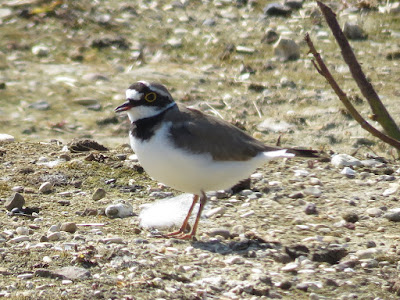I stopped for quite a while at South Marsh East. The gulls were in full swing, and 5 gull species were present, although only Herring, Black-headed and Lesser black-backed were sitting on nests. A few common gulls and greater black-backed immatures enjoyed the company of the others. A Buzzard flushed the gulls and several of the larger gulls took it on, mobbing it until it disappeared into the distance. There was an Oystercatcher and a couple of Common Terns around. A male Ruff was on one of the distant islands. Much entertainment was provided by a very close Little Ringed Plover pair.
I moved onto South Marsh West. A Reed Warbler was singing close to the hide, and he played hide and seek in the reeds.
On Watton, a pair of cormorants enjoyed a very vigorous wash, followed by some wing drying. There was a Canada Geese family and a pair of Lapwing, but I couldn't see any young. As I left, a Lesser Whitethroat sung by the path atop hawthorns.
By O reservoir I spotted a large dragonfly, which settled on the brambles by the path. I was pleased to find it was a male Hairy Hawker (top shot), a new species for me.
I moved onto the North side of the reserve. A Pied Wagtail foraged atop the D reservoir wall, mostly, I guess on the very numerous Marsh flies. With the clear skies D reservoir was a beautiful turquoise, not many birds about, the only one of note a drake Red Crested Pochard. Nothing much on the feeders. The woodland was busy with female chaffinches hawking for insects. One was hovering under the roof of the old visitor centre hunting for spiders. Obviously feeding chicks while males sung non stop.
I had my lunch at N Marsh in the usual company of a Moorhen. Later, a family of Greylag turned up. I had heard the call of the cuckoo at Watton and now here. I wonder if a single male had been moving around the reserve or there were more than one. I had also seen a cuckoo flying as I approached the reserve at Bridge House Farm.
At Hempholme meadows nothing much other than the loud chorus of the Marsh Frogs. They might all be quiet, but as one started calling several others joined in from different points in the marshes, each with a distinctive individual voice. On the way back at D woods, I noticed lots of Large Red Damselflies on the grassy sides.
On the butterfly front, there were Orange Tip, Green-veined white, many Peacock and a Red Admiral in D woods.
All in all, 64 bird species, which I think it is the most species I've seen in the UK in one day!
Young Moorhen chick
Alder fly, Sialis sp.
Great black-backed immature eyeing the sky.
Oystercatcher
Common Tern
Lesser black backed mobbing buzzard
Little ringed plover
Male Ruff
Reed Warbler singing from deep in the reeds.
A male zebra spider Salticus scenicus on a hide window.
Pied Wagtail.
Red crested pochard feeding.
Greylag family.
Male blackcap at D woods.
Male pheasant by the feeders.
Male chaffinch singing. The females were much harder to capture as they were very busy feeding chicks.
Male Red Damselfly.
Male Red Damselfly




















No comments:
Post a Comment